ISO 14001 EMS Report: NEMA Company Environmental Strategy
VerifiedAdded on 2023/01/23
|15
|3139
|31
Report
AI Summary
This report provides a comprehensive analysis of NEMA Company's Environmental Management System (EMS), focusing on its application of ISO 14001 standards to manage environmental responsibilities, particularly in its mining operations across Asia and its planned expansion into Europe. The report outlines the methodology, including a consultative approach and literature review, emphasizing the Plan-Do-Check-Act (PDCA) cycle for EMS implementation. It details the identification of significant environmental aspects, such as water discharge, waste management, and emissions, and their impact on the local and global environment. The report also discusses setting objectives, targets, and environmental programs to mitigate negative impacts. Furthermore, it advises management on the benefits of conducting an Environmental Impact Assessment (EIA) to improve project performance, highlighting cost savings and enhanced environmental awareness. The report incorporates relevant regulations and best practices, offering a practical guide for NEMA Company to achieve environmental compliance and sustainability.
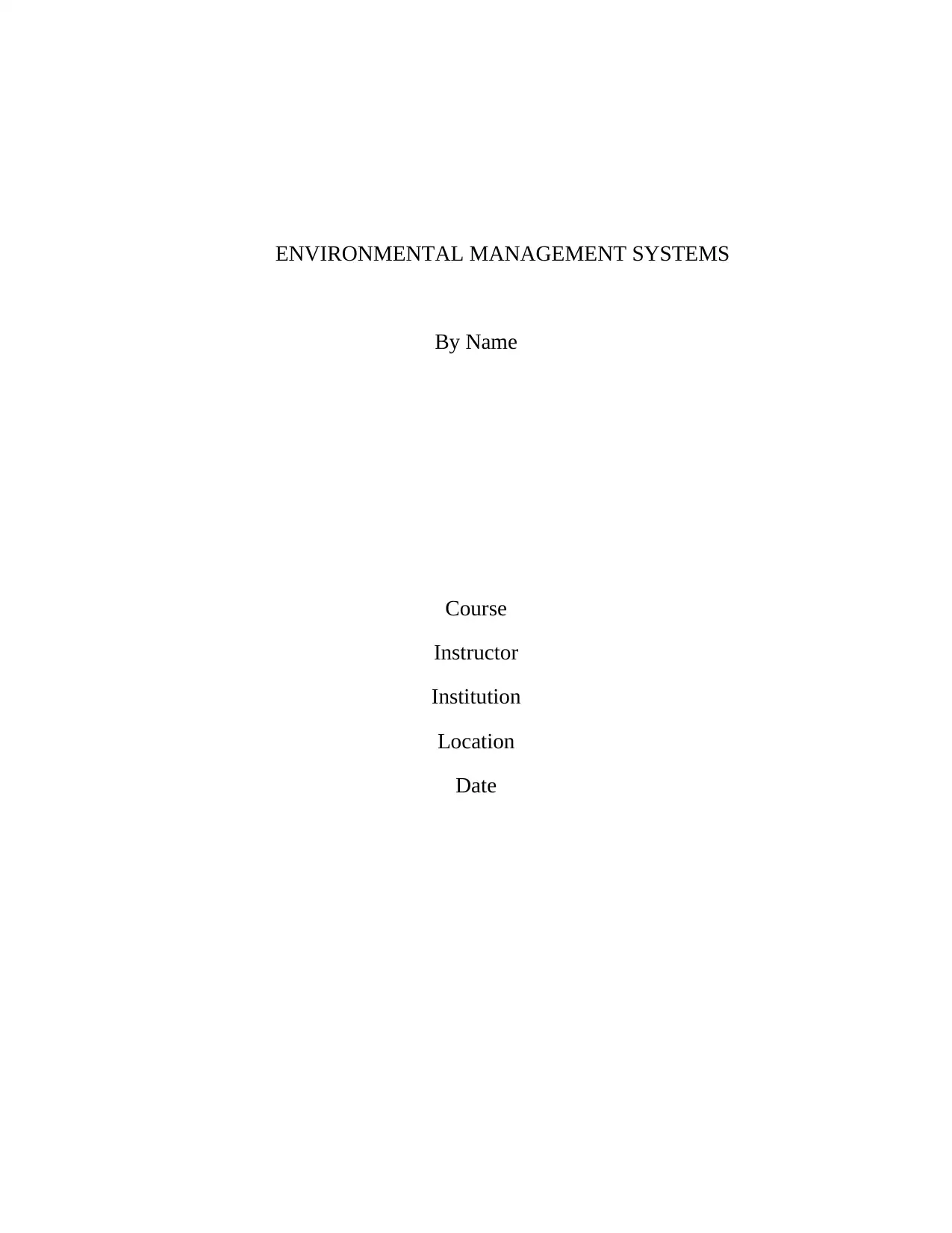
ENVIRONMENTAL MANAGEMENT SYSTEMS
By Name
Course
Instructor
Institution
Location
Date
By Name
Course
Instructor
Institution
Location
Date
Paraphrase This Document
Need a fresh take? Get an instant paraphrase of this document with our AI Paraphraser
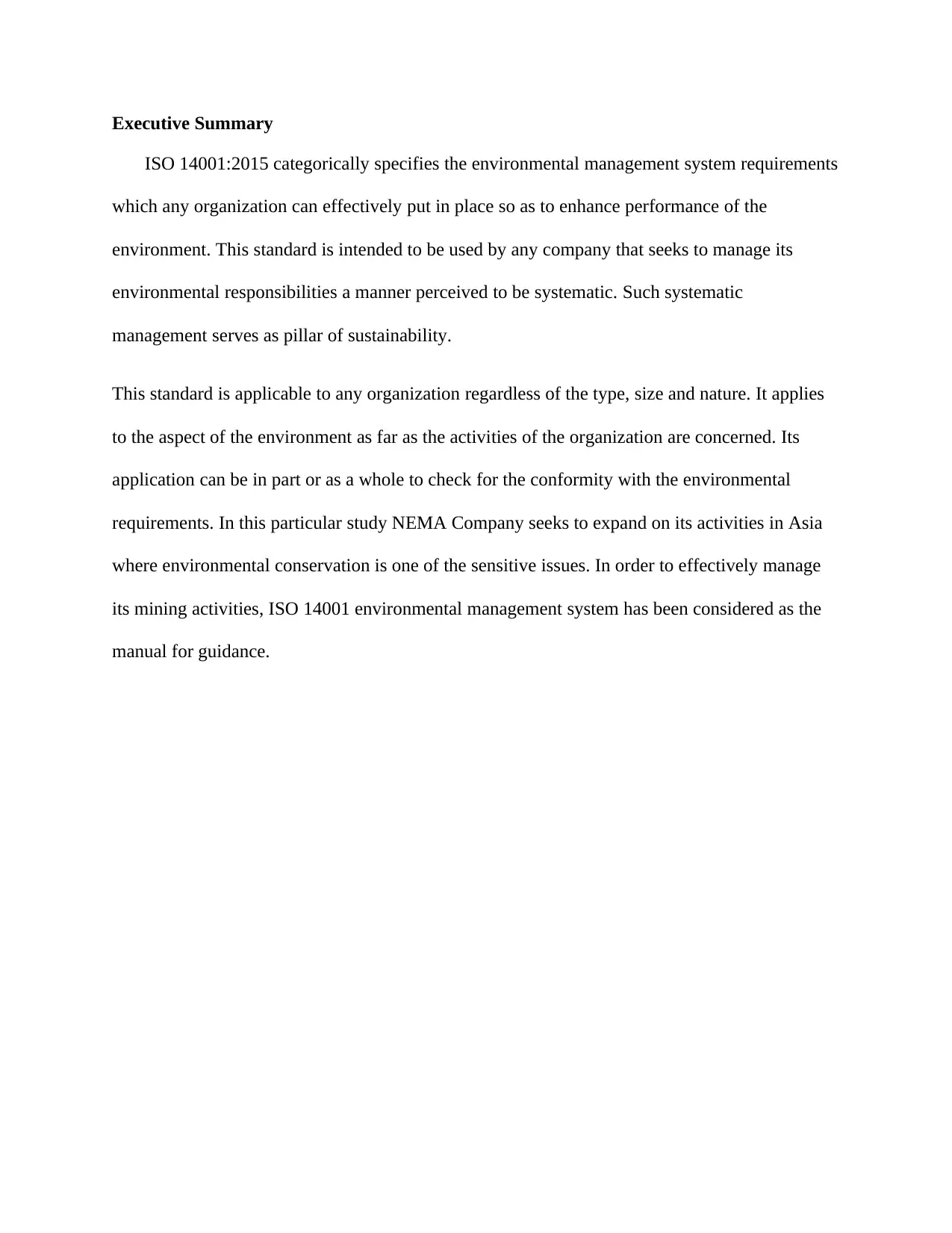
Executive Summary
ISO 14001:2015 categorically specifies the environmental management system requirements
which any organization can effectively put in place so as to enhance performance of the
environment. This standard is intended to be used by any company that seeks to manage its
environmental responsibilities a manner perceived to be systematic. Such systematic
management serves as pillar of sustainability.
This standard is applicable to any organization regardless of the type, size and nature. It applies
to the aspect of the environment as far as the activities of the organization are concerned. Its
application can be in part or as a whole to check for the conformity with the environmental
requirements. In this particular study NEMA Company seeks to expand on its activities in Asia
where environmental conservation is one of the sensitive issues. In order to effectively manage
its mining activities, ISO 14001 environmental management system has been considered as the
manual for guidance.
ISO 14001:2015 categorically specifies the environmental management system requirements
which any organization can effectively put in place so as to enhance performance of the
environment. This standard is intended to be used by any company that seeks to manage its
environmental responsibilities a manner perceived to be systematic. Such systematic
management serves as pillar of sustainability.
This standard is applicable to any organization regardless of the type, size and nature. It applies
to the aspect of the environment as far as the activities of the organization are concerned. Its
application can be in part or as a whole to check for the conformity with the environmental
requirements. In this particular study NEMA Company seeks to expand on its activities in Asia
where environmental conservation is one of the sensitive issues. In order to effectively manage
its mining activities, ISO 14001 environmental management system has been considered as the
manual for guidance.
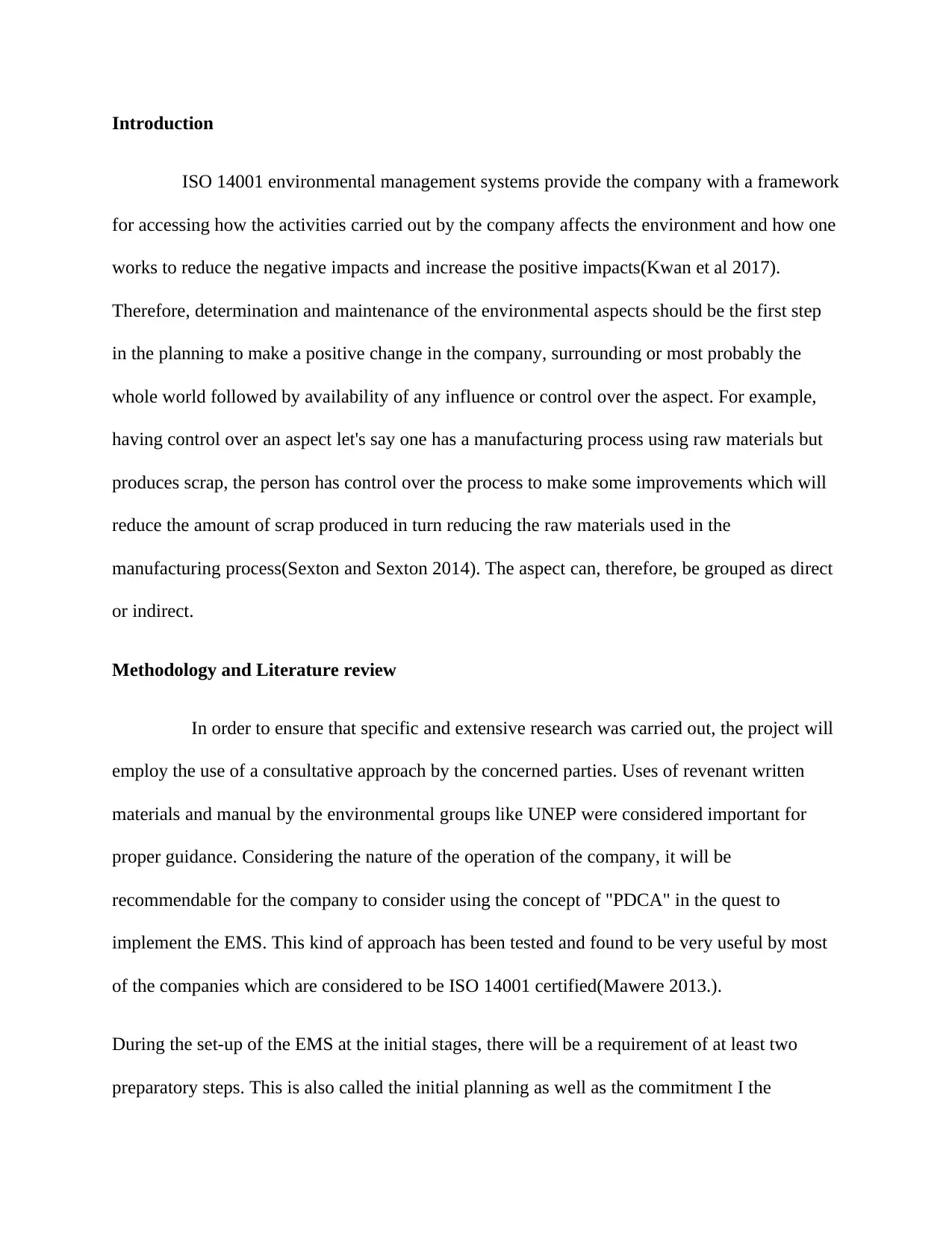
Introduction
ISO 14001 environmental management systems provide the company with a framework
for accessing how the activities carried out by the company affects the environment and how one
works to reduce the negative impacts and increase the positive impacts(Kwan et al 2017).
Therefore, determination and maintenance of the environmental aspects should be the first step
in the planning to make a positive change in the company, surrounding or most probably the
whole world followed by availability of any influence or control over the aspect. For example,
having control over an aspect let's say one has a manufacturing process using raw materials but
produces scrap, the person has control over the process to make some improvements which will
reduce the amount of scrap produced in turn reducing the raw materials used in the
manufacturing process(Sexton and Sexton 2014). The aspect can, therefore, be grouped as direct
or indirect.
Methodology and Literature review
In order to ensure that specific and extensive research was carried out, the project will
employ the use of a consultative approach by the concerned parties. Uses of revenant written
materials and manual by the environmental groups like UNEP were considered important for
proper guidance. Considering the nature of the operation of the company, it will be
recommendable for the company to consider using the concept of "PDCA" in the quest to
implement the EMS. This kind of approach has been tested and found to be very useful by most
of the companies which are considered to be ISO 14001 certified(Mawere 2013.).
During the set-up of the EMS at the initial stages, there will be a requirement of at least two
preparatory steps. This is also called the initial planning as well as the commitment I the
ISO 14001 environmental management systems provide the company with a framework
for accessing how the activities carried out by the company affects the environment and how one
works to reduce the negative impacts and increase the positive impacts(Kwan et al 2017).
Therefore, determination and maintenance of the environmental aspects should be the first step
in the planning to make a positive change in the company, surrounding or most probably the
whole world followed by availability of any influence or control over the aspect. For example,
having control over an aspect let's say one has a manufacturing process using raw materials but
produces scrap, the person has control over the process to make some improvements which will
reduce the amount of scrap produced in turn reducing the raw materials used in the
manufacturing process(Sexton and Sexton 2014). The aspect can, therefore, be grouped as direct
or indirect.
Methodology and Literature review
In order to ensure that specific and extensive research was carried out, the project will
employ the use of a consultative approach by the concerned parties. Uses of revenant written
materials and manual by the environmental groups like UNEP were considered important for
proper guidance. Considering the nature of the operation of the company, it will be
recommendable for the company to consider using the concept of "PDCA" in the quest to
implement the EMS. This kind of approach has been tested and found to be very useful by most
of the companies which are considered to be ISO 14001 certified(Mawere 2013.).
During the set-up of the EMS at the initial stages, there will be a requirement of at least two
preparatory steps. This is also called the initial planning as well as the commitment I the
⊘ This is a preview!⊘
Do you want full access?
Subscribe today to unlock all pages.

Trusted by 1+ million students worldwide
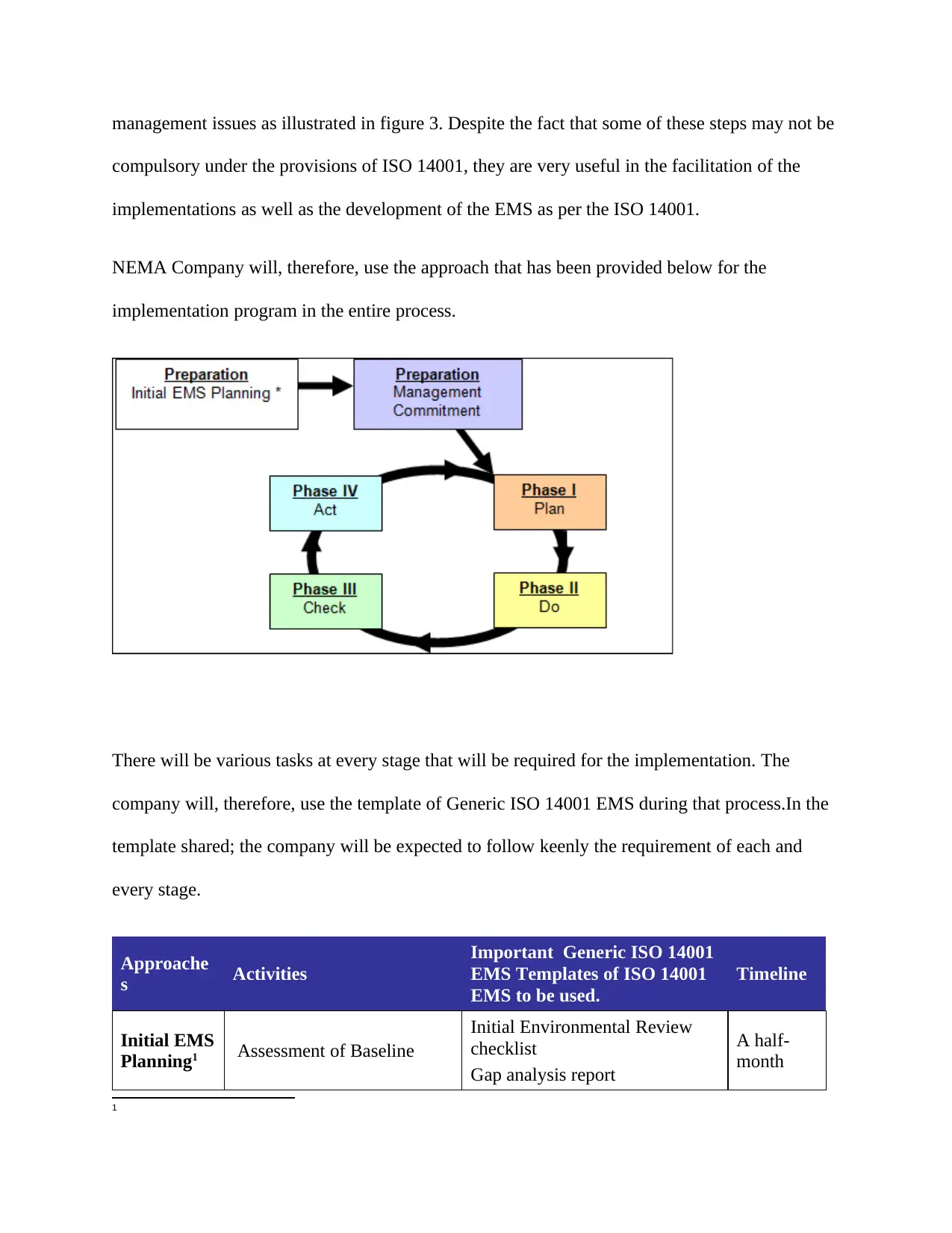
management issues as illustrated in figure 3. Despite the fact that some of these steps may not be
compulsory under the provisions of ISO 14001, they are very useful in the facilitation of the
implementations as well as the development of the EMS as per the ISO 14001.
NEMA Company will, therefore, use the approach that has been provided below for the
implementation program in the entire process.
There will be various tasks at every stage that will be required for the implementation. The
company will, therefore, use the template of Generic ISO 14001 EMS during that process.In the
template shared; the company will be expected to follow keenly the requirement of each and
every stage.
Approache
s Activities
Important Generic ISO 14001
EMS Templates of ISO 14001
EMS to be used.
Timeline
Initial EMS
Planning1 Assessment of Baseline
Initial Environmental Review
checklist
Gap analysis report
A half-
month
1
compulsory under the provisions of ISO 14001, they are very useful in the facilitation of the
implementations as well as the development of the EMS as per the ISO 14001.
NEMA Company will, therefore, use the approach that has been provided below for the
implementation program in the entire process.
There will be various tasks at every stage that will be required for the implementation. The
company will, therefore, use the template of Generic ISO 14001 EMS during that process.In the
template shared; the company will be expected to follow keenly the requirement of each and
every stage.
Approache
s Activities
Important Generic ISO 14001
EMS Templates of ISO 14001
EMS to be used.
Timeline
Initial EMS
Planning1 Assessment of Baseline
Initial Environmental Review
checklist
Gap analysis report
A half-
month
1
Paraphrase This Document
Need a fresh take? Get an instant paraphrase of this document with our AI Paraphraser
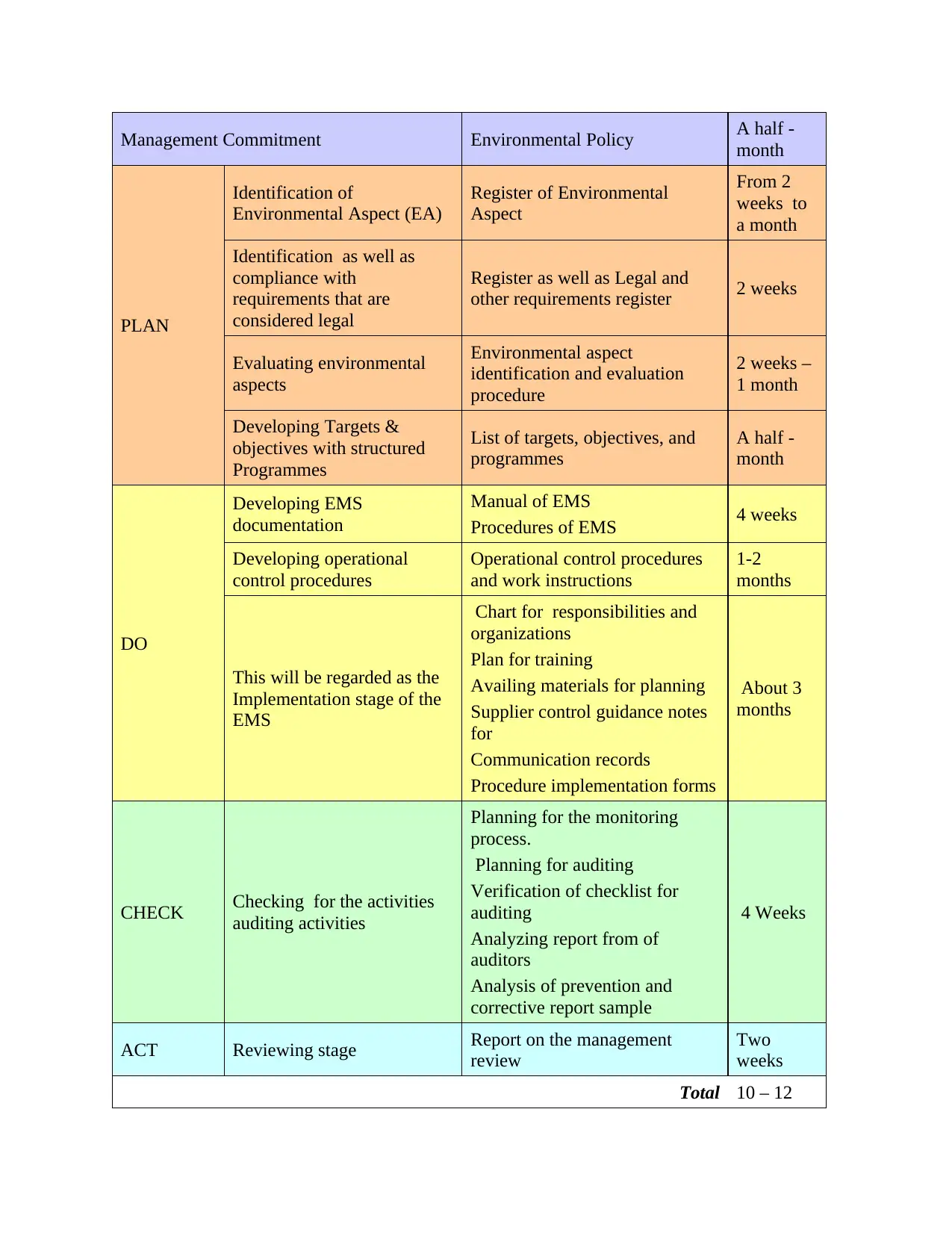
Management Commitment Environmental Policy A half -
month
PLAN
Identification of
Environmental Aspect (EA)
Register of Environmental
Aspect
From 2
weeks to
a month
Identification as well as
compliance with
requirements that are
considered legal
Register as well as Legal and
other requirements register 2 weeks
Evaluating environmental
aspects
Environmental aspect
identification and evaluation
procedure
2 weeks –
1 month
Developing Targets &
objectives with structured
Programmes
List of targets, objectives, and
programmes
A half -
month
DO
Developing EMS
documentation
Manual of EMS
Procedures of EMS 4 weeks
Developing operational
control procedures
Operational control procedures
and work instructions
1-2
months
This will be regarded as the
Implementation stage of the
EMS
Chart for responsibilities and
organizations
Plan for training
Availing materials for planning
Supplier control guidance notes
for
Communication records
Procedure implementation forms
About 3
months
CHECK Checking for the activities
auditing activities
Planning for the monitoring
process.
Planning for auditing
Verification of checklist for
auditing
Analyzing report from of
auditors
Analysis of prevention and
corrective report sample
4 Weeks
ACT Reviewing stage Report on the management
review
Two
weeks
Total 10 – 12
month
PLAN
Identification of
Environmental Aspect (EA)
Register of Environmental
Aspect
From 2
weeks to
a month
Identification as well as
compliance with
requirements that are
considered legal
Register as well as Legal and
other requirements register 2 weeks
Evaluating environmental
aspects
Environmental aspect
identification and evaluation
procedure
2 weeks –
1 month
Developing Targets &
objectives with structured
Programmes
List of targets, objectives, and
programmes
A half -
month
DO
Developing EMS
documentation
Manual of EMS
Procedures of EMS 4 weeks
Developing operational
control procedures
Operational control procedures
and work instructions
1-2
months
This will be regarded as the
Implementation stage of the
EMS
Chart for responsibilities and
organizations
Plan for training
Availing materials for planning
Supplier control guidance notes
for
Communication records
Procedure implementation forms
About 3
months
CHECK Checking for the activities
auditing activities
Planning for the monitoring
process.
Planning for auditing
Verification of checklist for
auditing
Analyzing report from of
auditors
Analysis of prevention and
corrective report sample
4 Weeks
ACT Reviewing stage Report on the management
review
Two
weeks
Total 10 – 12
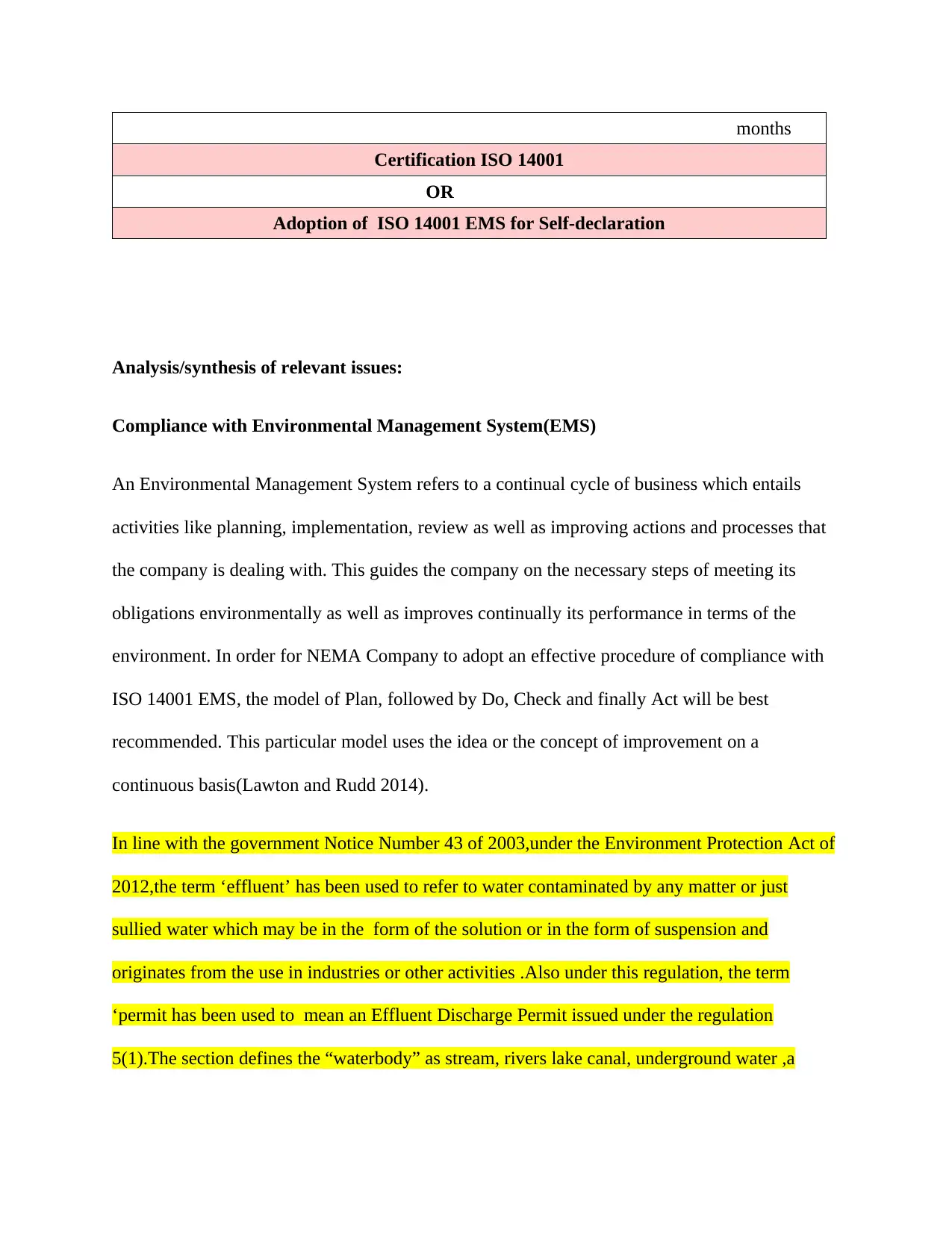
months
Certification ISO 14001
OR
Adoption of ISO 14001 EMS for Self-declaration
Analysis/synthesis of relevant issues:
Compliance with Environmental Management System(EMS)
An Environmental Management System refers to a continual cycle of business which entails
activities like planning, implementation, review as well as improving actions and processes that
the company is dealing with. This guides the company on the necessary steps of meeting its
obligations environmentally as well as improves continually its performance in terms of the
environment. In order for NEMA Company to adopt an effective procedure of compliance with
ISO 14001 EMS, the model of Plan, followed by Do, Check and finally Act will be best
recommended. This particular model uses the idea or the concept of improvement on a
continuous basis(Lawton and Rudd 2014).
In line with the government Notice Number 43 of 2003,under the Environment Protection Act of
2012,the term ‘effluent’ has been used to refer to water contaminated by any matter or just
sullied water which may be in the form of the solution or in the form of suspension and
originates from the use in industries or other activities .Also under this regulation, the term
‘permit has been used to mean an Effluent Discharge Permit issued under the regulation
5(1).The section defines the “waterbody” as stream, rivers lake canal, underground water ,a
Certification ISO 14001
OR
Adoption of ISO 14001 EMS for Self-declaration
Analysis/synthesis of relevant issues:
Compliance with Environmental Management System(EMS)
An Environmental Management System refers to a continual cycle of business which entails
activities like planning, implementation, review as well as improving actions and processes that
the company is dealing with. This guides the company on the necessary steps of meeting its
obligations environmentally as well as improves continually its performance in terms of the
environment. In order for NEMA Company to adopt an effective procedure of compliance with
ISO 14001 EMS, the model of Plan, followed by Do, Check and finally Act will be best
recommended. This particular model uses the idea or the concept of improvement on a
continuous basis(Lawton and Rudd 2014).
In line with the government Notice Number 43 of 2003,under the Environment Protection Act of
2012,the term ‘effluent’ has been used to refer to water contaminated by any matter or just
sullied water which may be in the form of the solution or in the form of suspension and
originates from the use in industries or other activities .Also under this regulation, the term
‘permit has been used to mean an Effluent Discharge Permit issued under the regulation
5(1).The section defines the “waterbody” as stream, rivers lake canal, underground water ,a
⊘ This is a preview!⊘
Do you want full access?
Subscribe today to unlock all pages.

Trusted by 1+ million students worldwide
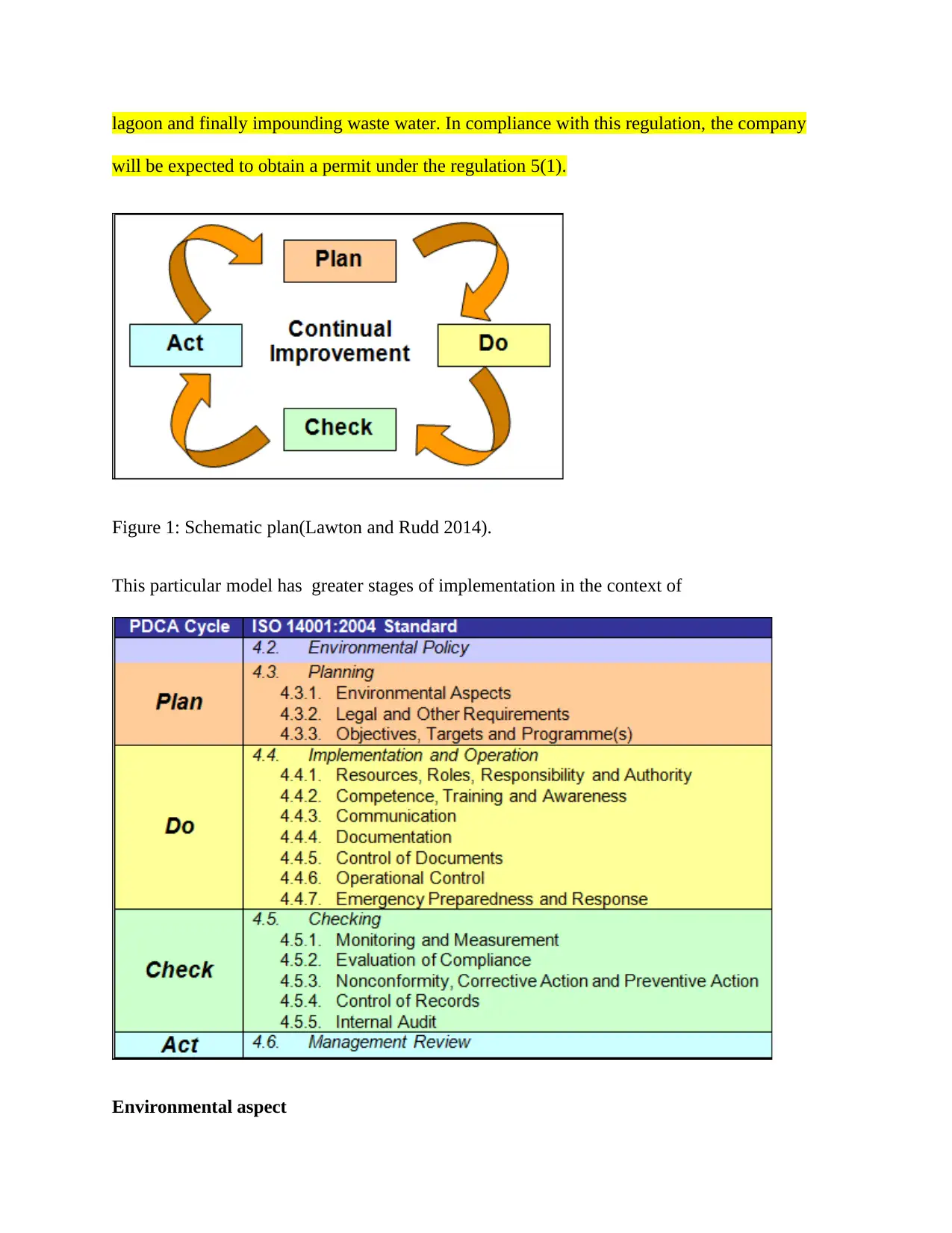
lagoon and finally impounding waste water. In compliance with this regulation, the company
will be expected to obtain a permit under the regulation 5(1).
Figure 1: Schematic plan(Lawton and Rudd 2014).
This particular model has greater stages of implementation in the context of
Environmental aspect
will be expected to obtain a permit under the regulation 5(1).
Figure 1: Schematic plan(Lawton and Rudd 2014).
This particular model has greater stages of implementation in the context of
Environmental aspect
Paraphrase This Document
Need a fresh take? Get an instant paraphrase of this document with our AI Paraphraser
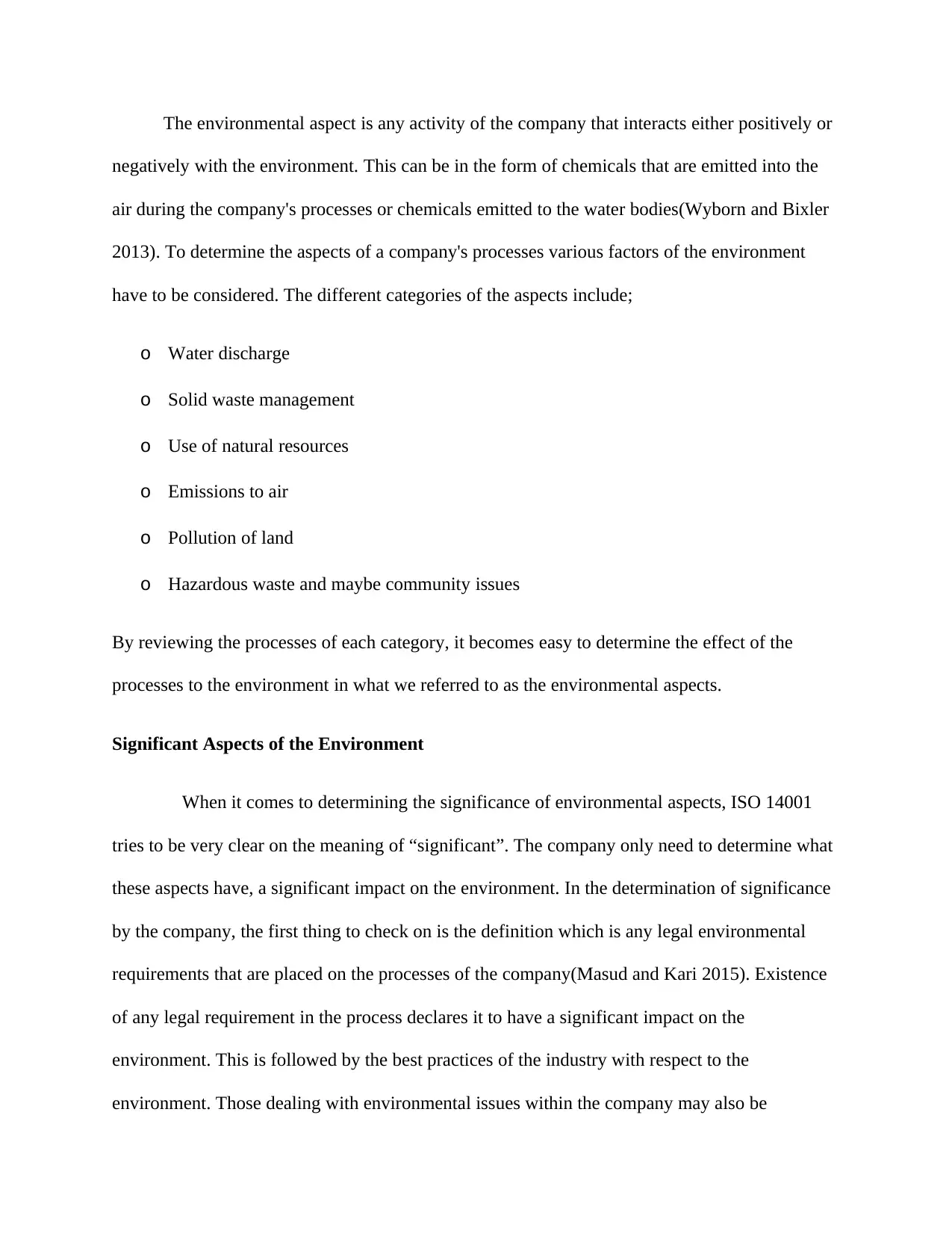
The environmental aspect is any activity of the company that interacts either positively or
negatively with the environment. This can be in the form of chemicals that are emitted into the
air during the company's processes or chemicals emitted to the water bodies(Wyborn and Bixler
2013). To determine the aspects of a company's processes various factors of the environment
have to be considered. The different categories of the aspects include;
o Water discharge
o Solid waste management
o Use of natural resources
o Emissions to air
o Pollution of land
o Hazardous waste and maybe community issues
By reviewing the processes of each category, it becomes easy to determine the effect of the
processes to the environment in what we referred to as the environmental aspects.
Significant Aspects of the Environment
When it comes to determining the significance of environmental aspects, ISO 14001
tries to be very clear on the meaning of “significant”. The company only need to determine what
these aspects have, a significant impact on the environment. In the determination of significance
by the company, the first thing to check on is the definition which is any legal environmental
requirements that are placed on the processes of the company(Masud and Kari 2015). Existence
of any legal requirement in the process declares it to have a significant impact on the
environment. This is followed by the best practices of the industry with respect to the
environment. Those dealing with environmental issues within the company may also be
negatively with the environment. This can be in the form of chemicals that are emitted into the
air during the company's processes or chemicals emitted to the water bodies(Wyborn and Bixler
2013). To determine the aspects of a company's processes various factors of the environment
have to be considered. The different categories of the aspects include;
o Water discharge
o Solid waste management
o Use of natural resources
o Emissions to air
o Pollution of land
o Hazardous waste and maybe community issues
By reviewing the processes of each category, it becomes easy to determine the effect of the
processes to the environment in what we referred to as the environmental aspects.
Significant Aspects of the Environment
When it comes to determining the significance of environmental aspects, ISO 14001
tries to be very clear on the meaning of “significant”. The company only need to determine what
these aspects have, a significant impact on the environment. In the determination of significance
by the company, the first thing to check on is the definition which is any legal environmental
requirements that are placed on the processes of the company(Masud and Kari 2015). Existence
of any legal requirement in the process declares it to have a significant impact on the
environment. This is followed by the best practices of the industry with respect to the
environment. Those dealing with environmental issues within the company may also be
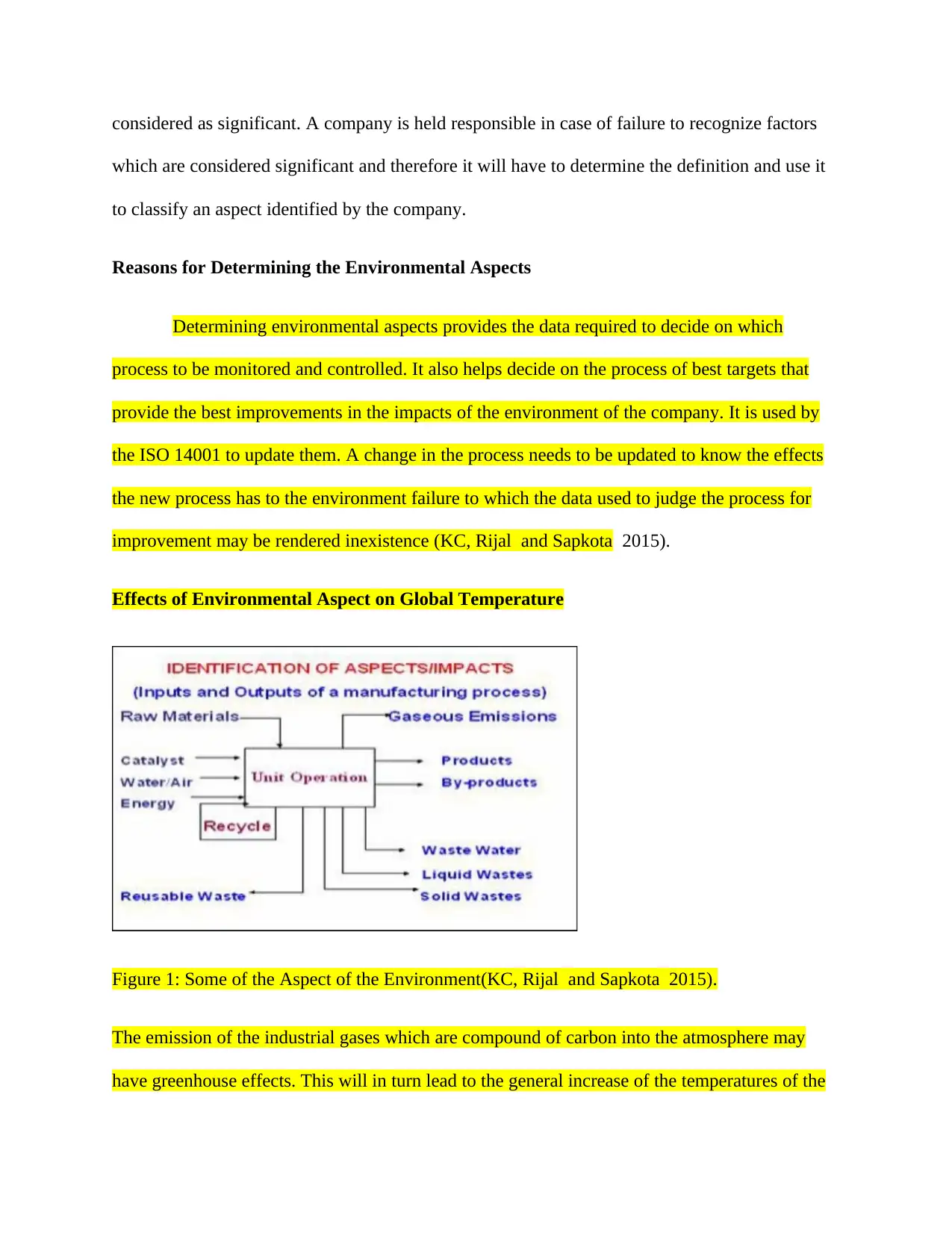
considered as significant. A company is held responsible in case of failure to recognize factors
which are considered significant and therefore it will have to determine the definition and use it
to classify an aspect identified by the company.
Reasons for Determining the Environmental Aspects
Determining environmental aspects provides the data required to decide on which
process to be monitored and controlled. It also helps decide on the process of best targets that
provide the best improvements in the impacts of the environment of the company. It is used by
the ISO 14001 to update them. A change in the process needs to be updated to know the effects
the new process has to the environment failure to which the data used to judge the process for
improvement may be rendered inexistence (KC, Rijal and Sapkota 2015).
Effects of Environmental Aspect on Global Temperature
Figure 1: Some of the Aspect of the Environment(KC, Rijal and Sapkota 2015).
The emission of the industrial gases which are compound of carbon into the atmosphere may
have greenhouse effects. This will in turn lead to the general increase of the temperatures of the
which are considered significant and therefore it will have to determine the definition and use it
to classify an aspect identified by the company.
Reasons for Determining the Environmental Aspects
Determining environmental aspects provides the data required to decide on which
process to be monitored and controlled. It also helps decide on the process of best targets that
provide the best improvements in the impacts of the environment of the company. It is used by
the ISO 14001 to update them. A change in the process needs to be updated to know the effects
the new process has to the environment failure to which the data used to judge the process for
improvement may be rendered inexistence (KC, Rijal and Sapkota 2015).
Effects of Environmental Aspect on Global Temperature
Figure 1: Some of the Aspect of the Environment(KC, Rijal and Sapkota 2015).
The emission of the industrial gases which are compound of carbon into the atmosphere may
have greenhouse effects. This will in turn lead to the general increase of the temperatures of the
⊘ This is a preview!⊘
Do you want full access?
Subscribe today to unlock all pages.

Trusted by 1+ million students worldwide
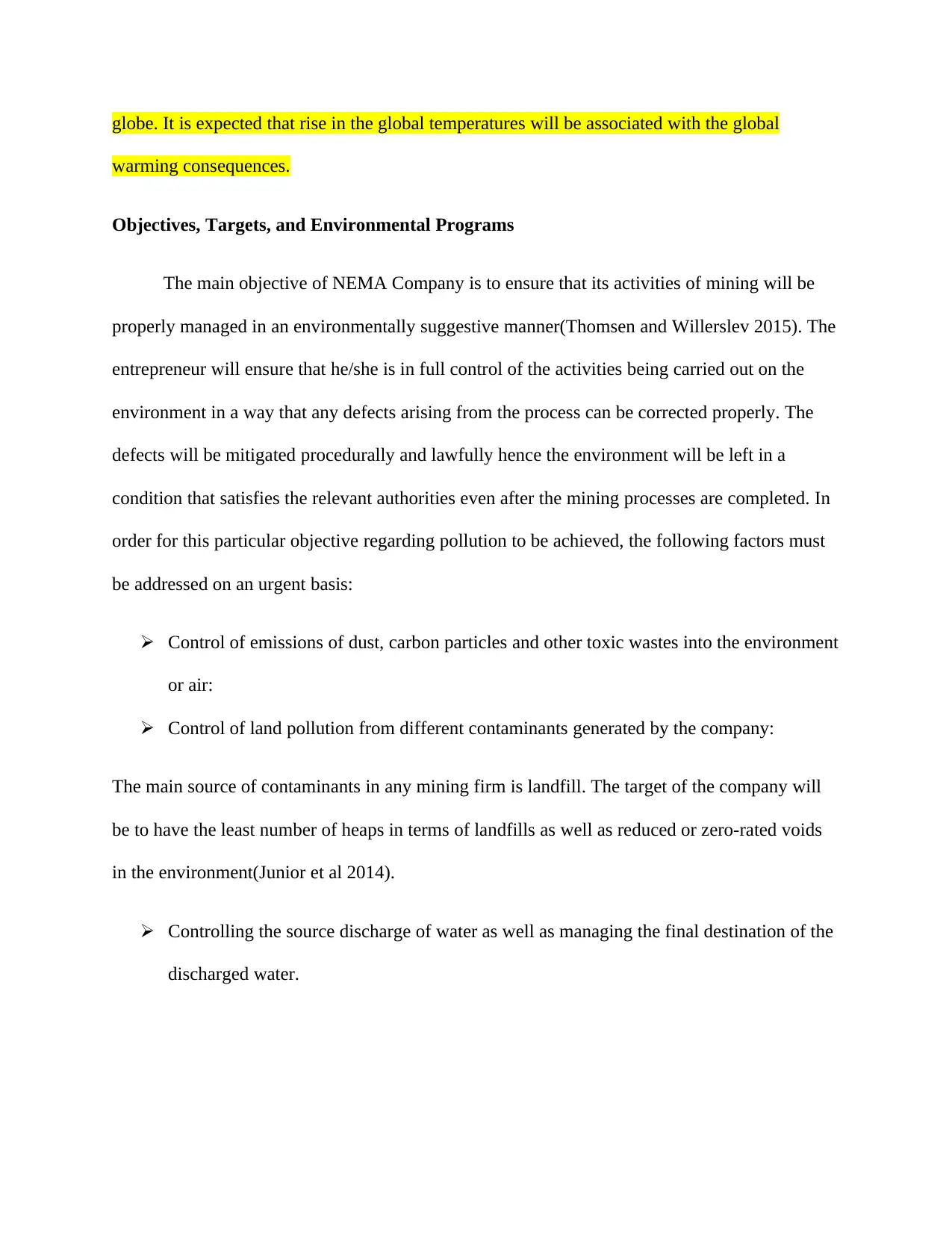
globe. It is expected that rise in the global temperatures will be associated with the global
warming consequences.
Objectives, Targets, and Environmental Programs
The main objective of NEMA Company is to ensure that its activities of mining will be
properly managed in an environmentally suggestive manner(Thomsen and Willerslev 2015). The
entrepreneur will ensure that he/she is in full control of the activities being carried out on the
environment in a way that any defects arising from the process can be corrected properly. The
defects will be mitigated procedurally and lawfully hence the environment will be left in a
condition that satisfies the relevant authorities even after the mining processes are completed. In
order for this particular objective regarding pollution to be achieved, the following factors must
be addressed on an urgent basis:
Control of emissions of dust, carbon particles and other toxic wastes into the environment
or air:
Control of land pollution from different contaminants generated by the company:
The main source of contaminants in any mining firm is landfill. The target of the company will
be to have the least number of heaps in terms of landfills as well as reduced or zero-rated voids
in the environment(Junior et al 2014).
Controlling the source discharge of water as well as managing the final destination of the
discharged water.
warming consequences.
Objectives, Targets, and Environmental Programs
The main objective of NEMA Company is to ensure that its activities of mining will be
properly managed in an environmentally suggestive manner(Thomsen and Willerslev 2015). The
entrepreneur will ensure that he/she is in full control of the activities being carried out on the
environment in a way that any defects arising from the process can be corrected properly. The
defects will be mitigated procedurally and lawfully hence the environment will be left in a
condition that satisfies the relevant authorities even after the mining processes are completed. In
order for this particular objective regarding pollution to be achieved, the following factors must
be addressed on an urgent basis:
Control of emissions of dust, carbon particles and other toxic wastes into the environment
or air:
Control of land pollution from different contaminants generated by the company:
The main source of contaminants in any mining firm is landfill. The target of the company will
be to have the least number of heaps in terms of landfills as well as reduced or zero-rated voids
in the environment(Junior et al 2014).
Controlling the source discharge of water as well as managing the final destination of the
discharged water.
Paraphrase This Document
Need a fresh take? Get an instant paraphrase of this document with our AI Paraphraser
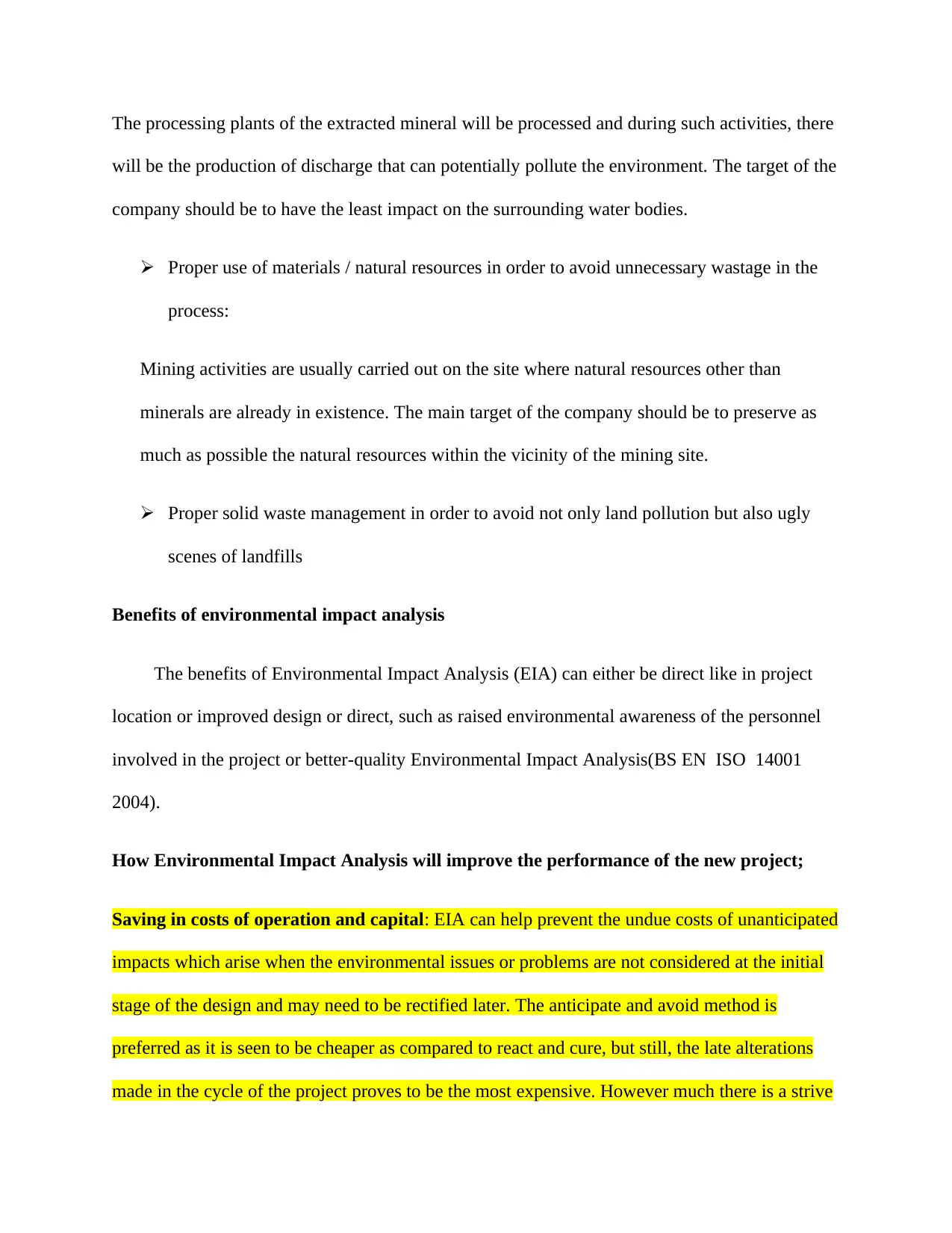
The processing plants of the extracted mineral will be processed and during such activities, there
will be the production of discharge that can potentially pollute the environment. The target of the
company should be to have the least impact on the surrounding water bodies.
Proper use of materials / natural resources in order to avoid unnecessary wastage in the
process:
Mining activities are usually carried out on the site where natural resources other than
minerals are already in existence. The main target of the company should be to preserve as
much as possible the natural resources within the vicinity of the mining site.
Proper solid waste management in order to avoid not only land pollution but also ugly
scenes of landfills
Benefits of environmental impact analysis
The benefits of Environmental Impact Analysis (EIA) can either be direct like in project
location or improved design or direct, such as raised environmental awareness of the personnel
involved in the project or better-quality Environmental Impact Analysis(BS EN ISO 14001
2004).
How Environmental Impact Analysis will improve the performance of the new project;
Saving in costs of operation and capital: EIA can help prevent the undue costs of unanticipated
impacts which arise when the environmental issues or problems are not considered at the initial
stage of the design and may need to be rectified later. The anticipate and avoid method is
preferred as it is seen to be cheaper as compared to react and cure, but still, the late alterations
made in the cycle of the project proves to be the most expensive. However much there is a strive
will be the production of discharge that can potentially pollute the environment. The target of the
company should be to have the least impact on the surrounding water bodies.
Proper use of materials / natural resources in order to avoid unnecessary wastage in the
process:
Mining activities are usually carried out on the site where natural resources other than
minerals are already in existence. The main target of the company should be to preserve as
much as possible the natural resources within the vicinity of the mining site.
Proper solid waste management in order to avoid not only land pollution but also ugly
scenes of landfills
Benefits of environmental impact analysis
The benefits of Environmental Impact Analysis (EIA) can either be direct like in project
location or improved design or direct, such as raised environmental awareness of the personnel
involved in the project or better-quality Environmental Impact Analysis(BS EN ISO 14001
2004).
How Environmental Impact Analysis will improve the performance of the new project;
Saving in costs of operation and capital: EIA can help prevent the undue costs of unanticipated
impacts which arise when the environmental issues or problems are not considered at the initial
stage of the design and may need to be rectified later. The anticipate and avoid method is
preferred as it is seen to be cheaper as compared to react and cure, but still, the late alterations
made in the cycle of the project proves to be the most expensive. However much there is a strive
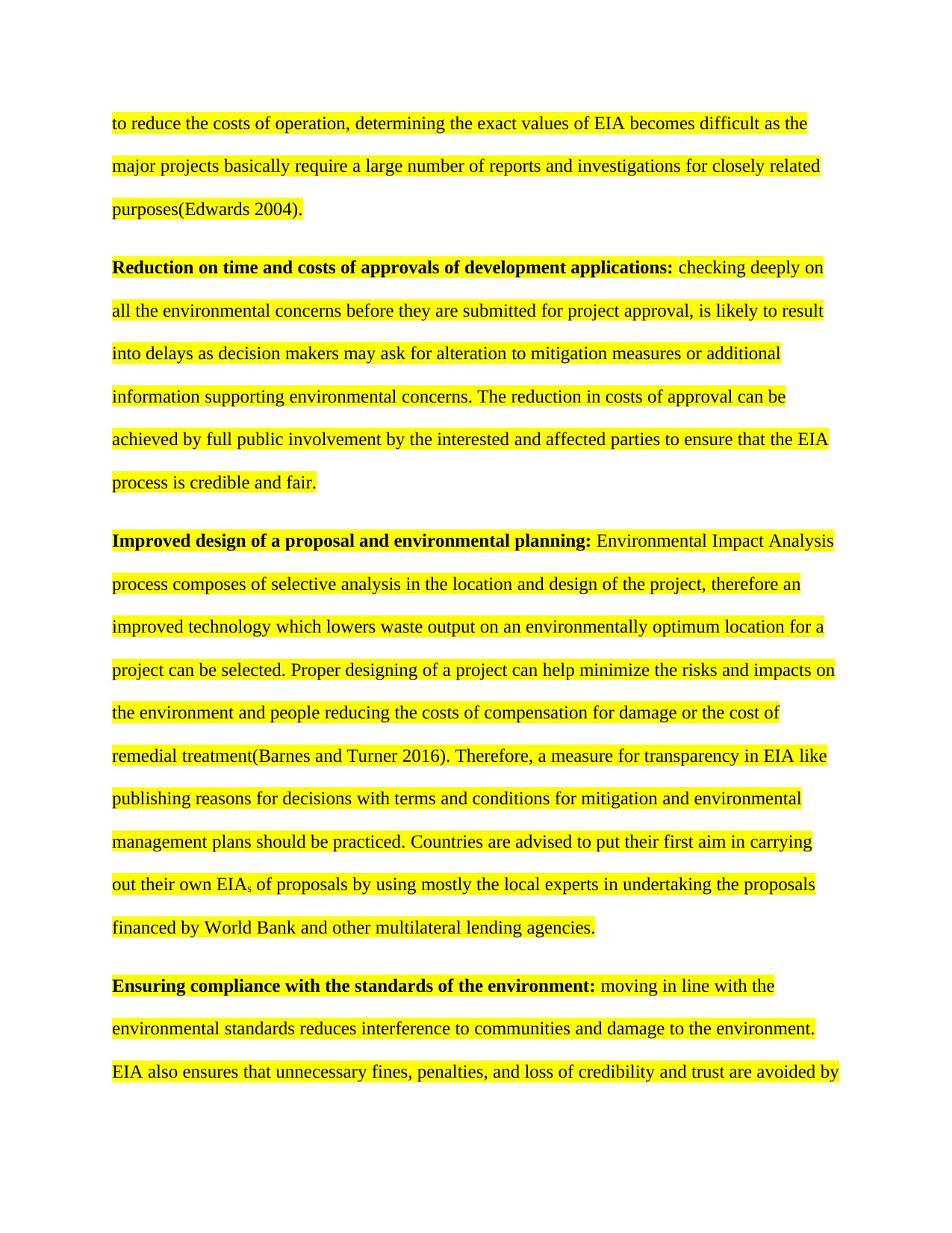
to reduce the costs of operation, determining the exact values of EIA becomes difficult as the
major projects basically require a large number of reports and investigations for closely related
purposes(Edwards 2004).
Reduction on time and costs of approvals of development applications: checking deeply on
all the environmental concerns before they are submitted for project approval, is likely to result
into delays as decision makers may ask for alteration to mitigation measures or additional
information supporting environmental concerns. The reduction in costs of approval can be
achieved by full public involvement by the interested and affected parties to ensure that the EIA
process is credible and fair.
Improved design of a proposal and environmental planning: Environmental Impact Analysis
process composes of selective analysis in the location and design of the project, therefore an
improved technology which lowers waste output on an environmentally optimum location for a
project can be selected. Proper designing of a project can help minimize the risks and impacts on
the environment and people reducing the costs of compensation for damage or the cost of
remedial treatment(Barnes and Turner 2016). Therefore, a measure for transparency in EIA like
publishing reasons for decisions with terms and conditions for mitigation and environmental
management plans should be practiced. Countries are advised to put their first aim in carrying
out their own EIAs of proposals by using mostly the local experts in undertaking the proposals
financed by World Bank and other multilateral lending agencies.
Ensuring compliance with the standards of the environment: moving in line with the
environmental standards reduces interference to communities and damage to the environment.
EIA also ensures that unnecessary fines, penalties, and loss of credibility and trust are avoided by
major projects basically require a large number of reports and investigations for closely related
purposes(Edwards 2004).
Reduction on time and costs of approvals of development applications: checking deeply on
all the environmental concerns before they are submitted for project approval, is likely to result
into delays as decision makers may ask for alteration to mitigation measures or additional
information supporting environmental concerns. The reduction in costs of approval can be
achieved by full public involvement by the interested and affected parties to ensure that the EIA
process is credible and fair.
Improved design of a proposal and environmental planning: Environmental Impact Analysis
process composes of selective analysis in the location and design of the project, therefore an
improved technology which lowers waste output on an environmentally optimum location for a
project can be selected. Proper designing of a project can help minimize the risks and impacts on
the environment and people reducing the costs of compensation for damage or the cost of
remedial treatment(Barnes and Turner 2016). Therefore, a measure for transparency in EIA like
publishing reasons for decisions with terms and conditions for mitigation and environmental
management plans should be practiced. Countries are advised to put their first aim in carrying
out their own EIAs of proposals by using mostly the local experts in undertaking the proposals
financed by World Bank and other multilateral lending agencies.
Ensuring compliance with the standards of the environment: moving in line with the
environmental standards reduces interference to communities and damage to the environment.
EIA also ensures that unnecessary fines, penalties, and loss of credibility and trust are avoided by
⊘ This is a preview!⊘
Do you want full access?
Subscribe today to unlock all pages.

Trusted by 1+ million students worldwide
1 out of 15
Related Documents
Your All-in-One AI-Powered Toolkit for Academic Success.
+13062052269
info@desklib.com
Available 24*7 on WhatsApp / Email
![[object Object]](/_next/static/media/star-bottom.7253800d.svg)
Unlock your academic potential
Copyright © 2020–2025 A2Z Services. All Rights Reserved. Developed and managed by ZUCOL.




